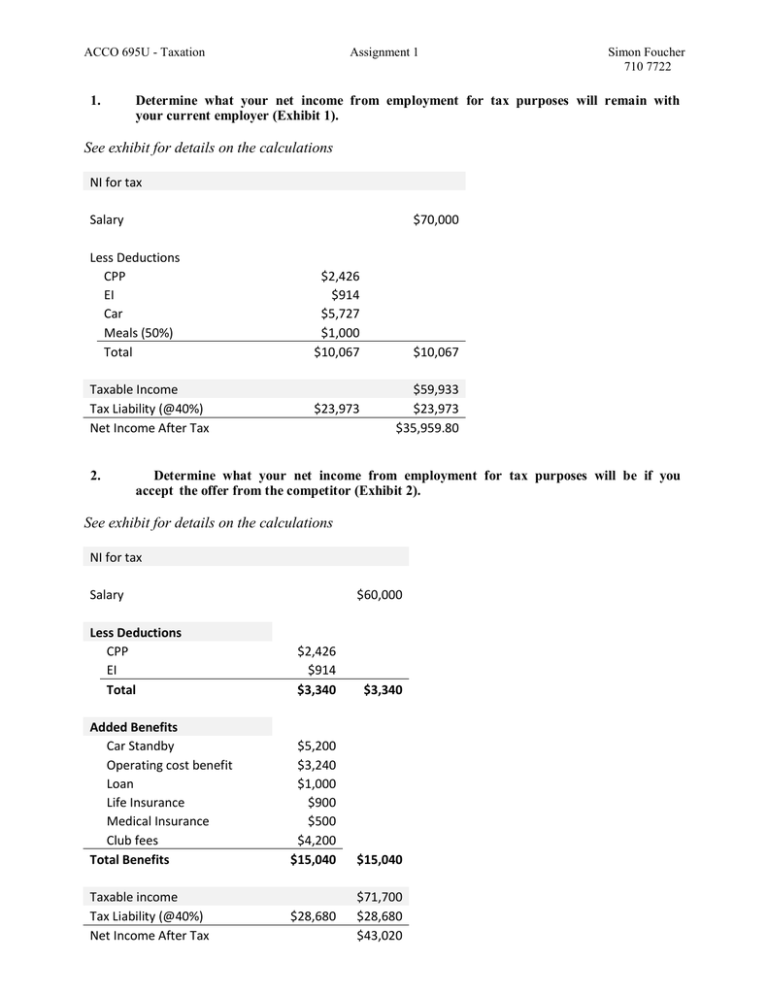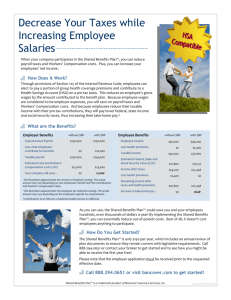ACCO 695U - Assignment 1
advertisement

ACCO 695U - Taxation 1. Assignment 1 Simon Foucher 710 7722 Determine what your net income from employment for tax purposes will remain with your current employer (Exhibit 1). See exhibit for details on the calculations NI for tax Salary $70,000 Less Deductions CPP EI Car Meals (50%) Total Taxable Income Tax Liability (@40%) Net Income After Tax 2. $2,426 $914 $5,727 $1,000 $10,067 $23,973 $10,067 $59,933 $23,973 $35,959.80 Determine what your net income from employment for tax purposes will be if you accept the offer from the competitor (Exhibit 2). See exhibit for details on the calculations NI for tax Salary Less Deductions CPP EI Total Added Benefits Car Standby Operating cost benefit Loan Life Insurance Medical Insurance Club fees Total Benefits Taxable income Tax Liability (@40%) Net Income After Tax $60,000 $2,426 $914 $3,340 $3,340 $5,200 $3,240 $1,000 $900 $500 $4,200 $15,040 $15,040 $28,680 $71,700 $28,680 $43,020 ACCO 695U - Taxation 3. Assignment 1 Simon Foucher 710 7722 Assuming that you pays tax at a rate of 40%, determine the amount by which your personal disposable income will increase (or decrease) if you accept the new offer. Item Salary CPP&EI Meals While Traveling Car Expenses* Tax Liability Interest ** Life Insurance Medical Insurance House Insurance Golf club fees Total Cash Flow Job1 $70,000 ($3,340) ($2,000) ($12,600) ($23,973) ($4,000) ($1,200) ($1,600) ($2,000) ($4,200) $15,087 Delta Job2 $60,000 ($3,340) $0 $0 ($28,680) ($1,000) $0 $0 ($2,000) $0 $24,980 $9,893 *This cash flow assessment ignores the following items (and potentially other car related expenses): Sales tax on lease payment Any costs associated with breaking existing lease if the lease on the current car is not yet expired Refund on plates on current car for the remainder of the year **Assuming fixed 100k$ in capital throughout the year and ignoring CFs related to principal reimbursement assumed to be equal. Disposable income will increase by $9,893 by taking the second offer. It could further increase by leveraging Standby charge reduction if he can manage to reduce personal driving < 50% total mileage (or increase work related driving) ACCO 695U - Taxation Assignment 1 Simon Foucher 710 7722 Exhibit 1: Information regarding current employment and certain other expenditures 1. Your gross salary next year will be $70,000. From this, the employer will deduct the required income tax, Canada Pension Plan contributions of $2,426, and Employment Insurance premiums of $914. CPP and EI have an impact on cash, but offer non-refundable tax credits therefor minimize taxable income. http://turbotax.intuit.ca/tax-resources/tax-deductions/can-i-claim-a-tax-credit-for-cpp-contributions.jsp http://turbotax.intuit.ca/tax-resources/tax-deductions/can-i-claim-a-tax-credit-for-ei-premiums.jsp 2. It is part of your ordinary duty to work on equipment at locations other than the main repair depot. On average, you are called out of town two or three days each month. On such trips, you must always stay overnight in a hotel. Your contract of employment requires that you pay your own automobile expenses. The company reimburses you for your hotel costs (lodging but not meals). No reimbursement is made for the vehicle. Hotel reimbursed – no impact on CF or tax. Meals expenses offer deductions at 50%, and full reduction of disposable income. 3. You lease your own car at $500 per month. You incurred the following additional travel costs in the current year: Insurance Repairs and maintenance Gasoline Meals (out of town) $ 1.800 600 4,200 2,000 During the year, you drove a total of 22,000 kilometres, of which 10,000 were for your employer. You anticipate that travel costs in the future will be about the same as they were this year. Lease doesn’t exceed 800$/monts. If we assume that lease cost is 500$ plus tax, can claim 500$ in tax credit, but required to pay 575$ (500$ + 15% sales taxes – sales taxes was ignored in CF calculations) Note – will require a T2200 signed by employer to claim the credits Car related expenses Lease Insurance Repairs Gasoline Total Mielage Personal Work Total $6,000 $1,800 $600 $4,200 $12,600 Qty % Cost allocation 12000 55% $6,873 10000 45% $5,727 22000 100% $12,600 ACCO 695U - Taxation 4. Assignment 1 Simon Foucher 710 7722 You will take possession of your new home in three months, and you are currently shopping for a mortgage. You expect to obtain a $100,000 mortgage with interest at 4% for a term of five years. No impact on taxes, impact on CF can’t be fully assessed without knowing amortization period (or total monthly payment), and compounding frequency. Ignoring capital payments and reduction in load principal, we can simply assume the impact on CF will be the interest rate compounded annually applied on the full loan amount: $4,000. 5. You maintain the following insurance policies: Term life insurance of $300,000 Private medical insurance House fire insurance Premium cost $1,200 1,600 2,000 House and fire – since not an office at home, can’t claim deductions. Premiums paid for life insurance policies are not a deduction on your tax return. Medical Expense Tax Credit (http://www.taxtips.ca/filing/eligiblemedicalexpenses.htm) Premiums paid to a private health services plan are considered a medical expense. Only expenses in excess of the lesser of $2,171 for 2014 ($2,208 for 2015) or 3% of net income can be claimed for the federal tax credit. The lowest tax rate is applied to the medical expenses to determine the amount of the tax credit. Since premiums of $1,600 do not exceed $2,171 or 3% of 70,000=2,100, assuming these are the only medical expenses incurred, they will not impact Net Income for taxes. The premiums will impact CF. 6. You are an avid golfer and belong to a private club. Your annual membership dues are $4,200. Specifically not deductible; and full impact on CF. Exhibit 2: Information regarding offer of employment with competitor 1. The proposed salary is $60,000 per year. From that amount, the employer will deduct the required income tax, Canada Pension Plan contributions of $2,426, and Employment Insurance premiums of $914. 2. The employer will lease an automobile identical to the one currently used by you. However, the employer’s lease cost will be only $650 per month because of a fleet discount. In addition, the employer will pay the annual insurance cost of $1,800, the repair and maintenance costs, which are estimated to be $600 annually, and the gasoline costs of $4,200. You will be entitled to operate the car for personal use. The number of business kilometres and personal kilometres driven will be the same as they are now. The employer will pay for all out-of-town meals when an overnight stay is required. The cost of meals is expected to be $2,000 per year. Meals and hotel: Since traveling for business, no impact on taxable income. Since fully subsidized, no impact on cash flow. ACCO 695U - Taxation Assignment 1 Simon Foucher 710 7722 For the car, since employee was already paying 500$/month for the lease, the “fleet” discount @$650 is not that great… Standby charge: Taxable benefit from lease: 650$ x 2/3 x 12 = $5,200 added to taxable income Since the distance travelled for personal is 12,000km > 10,000km travelled for work, there is no reduction of standby charge. Note: he should look into reducing personal use of car to 9,999km per year; in this way, the standby charge would be reduced to: $650 x 2/3 x 12 x (9,999/(12x1667) = $2,599 Compared to the original $5,200, this reduces taxable income by $2,601. In the 40% bracket, this would yield an additional 2,601x0.4 = 1,041$ of residual income. Operating cost benefit: $0.27 x 12,000 km (personal) = $3,240 4. As a senior mechanic, You will be entitled to a low-interest loan (1%) from the employer of up to five years’ duration. Such loans can be renewed at the end of term. The maximum loan amount is $100,000. Assume the prescribed interest rate set by the CRA is currently 2%. This loan can be used to purchase the new home. Taxable benefit = prescribed rate – actual interest = 2% - 1 % = 1%. For the next year, ignoring the reduction of capital on the loan, the reduction in interest benefit is $100,000 x 1% = $1,000 5. The employer maintains a group term life insurance program and a private medical insurance program. At no cost to you, the employer will provide $300,000 of group term life insurance as well as medical coverage equal to what he currently has. The premium costs to the employer will be as follows: Life insurance $900 Medical insurance 500 These amounts are lower than your current costs because group discounts are available to the employer. These are taxable benefits, therefore will be added to taxable income. http://www.cra-arc.gc.ca/tx/bsnss/tpcs/pyrll/bnfts/hlth/prvncl-eng.html http://www.cra-arc.gc.ca/tx/bsnss/tpcs/pyrll/bnfts/hlth/grp-eng.html 6. The employer has agreed to pay your annual golf club dues of $4,200. As you do not entertain and deal with customers, the employer derives no benefit from your membership in the club. Added to taxable revenue.





